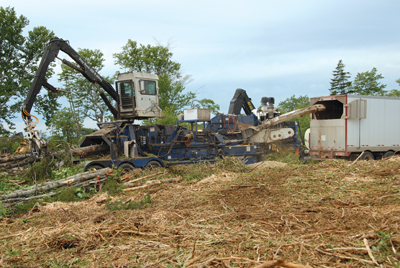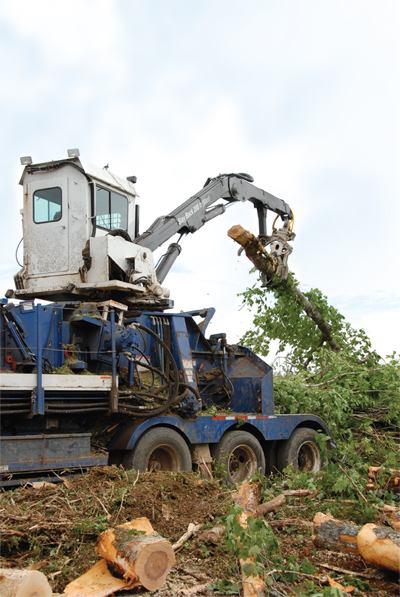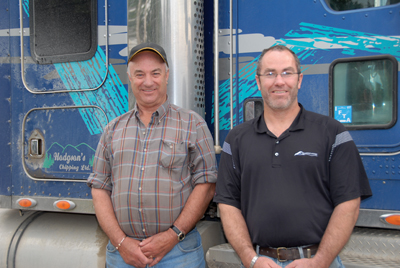
The Chipping Route
October 20, 2009
By Bill Tice
McKay Hodgson has seen a lot of changes in the logging industry since he first started in the business back in the mid-1960s. And he is on the cusp of seeing a lot more.
McKay Hodgson has seen a lot of changes in the logging industry since he first started in the business back in the mid-1960s. And he is on the cusp of seeing a lot more.
 |
|
| The contractor runs both Peterson chippers and grinders depending on the job.
|
Hodgson has progressed from being a two-man and one-horse logging show to one of Nova Scotia’s largest logging contractors. Along the way, he has seen his family-owned and -operated business change gears many times to adapt to the market. Throughout the changes, however, one thing has remained consistent: the volume of chipping and grinding they handle has continued to grow. Now, with biomass, they expect it will grow even more.
Today, the Truro, Nova Scotia-based company, which is appropriately called Hodgson’s Chipping, employs approximately 70 people, but has had as many as 85 employees on the payroll during peak times. They still harvest timber for local sawmills and pulp mills, but they also run four chippers and a grinder. In total, they have the capacity to harvest over 300,000 tonnes of wood every year, and more than half of that production will be destined for the chip pile at one of the province’s pulp mills, or the growing biomass business in Nova Scotia.
Getting Started
The Hodgsons fell into the chipping business quite by accident. It all started back in 1987 when McKay’s eldest son, Vaughn, joined the company. He had been working as a mechanic at a local truck dealership, but decided it was time to bring his mechanical skills to the family business. Not long after Vaughn came to work with McKay, the pair had “an interesting offer” from the local Scott Paper mill. “A Peterson 5000 prototype chipper had been brought into the area to do work for the mill, but being the first of its kind ever built, they had a few issues with it,” Vaughn explains. “We like a bit of a challenge, and the people at Scott Paper were aware of that, so they came to us and asked us if we were interested in it. We jumped at the opportunity and although it took a lot of modifications, we got it running the way we wanted and we are still using it to this day.”
 |
|
| Trucking of both logs and chips is done by Hodgson’s own fleet of 25 trucks and trailers.
|
The mill that encouraged the Hodgsons to go into the chipping business is still one of their biggest customers. Located at Abercrombie Point near New Glasgow, the facility has gone through several ownership changes since 1987; it has operated under the management of Kimberly-Clark and Neenah Paper prior to the latest change that saw the Northern Pulp Nova Scotia Corporation take over the mill in 2008. Through all of its ownership changes, the Hodgsons have continued to deliver wood fibre to the mill, and today, in addition to supplying chips for the pulp-making process, they supply wood fibre for the mill’s biomass-powered energy system.
Vaughn credits Jamie Stalker for getting the Hodgsons started down the chipping road, but he says unfortunately, the long-term Abercrombie mill employee passed away before seeing the chipping and grinding program reach its full potential. “Jamie was one of the driving forces behind the development of that first chipper coming to Nova Scotia,” Vaughn explains. “He also saw the need for the development of a new grinder that could handle the waste from mechanized operations and turn it into a viable product – energy. That is something we are working on right now with the mill and with Peterson, but without Jamie’s hard work and dedication to Scott Paper and the other companies that have operated the mill over the past two decades, we may not have had the opportunity to work with these products in this province. We have to say that without Jamie’s vision, we wouldn’t be as far along in this program as we are.”
Chipping Gear
Today, Hodgson’s Chipping operates a Peterson 4710B grinder and four Peterson chippers – the original prototype 5000 they picked up from Scott Paper, along with F, G, and H models.
Three of the chippers are primarily dedicated to working in the woods, where they fill vans for delivery to Northern Pulp. The fourth chipper is on standby for the busy season at Northern Pulp and may do biomass or custom chipping for other customers. One of the chippers is currently completing test runs at the New Page paper mill at Port Hawkesbury, which is located on the Cape Breton side of the Strait of Canso, a body of water that separates Cape Breton from mainland Nova Scotia.
On the biomass side of the business, Vaughn says that in addition to supplying the biomass-powered energy program at the Abercrombie mill, they supply fibre to Brooklyn Energy in Liverpool, Nova Scotia, which in turn supplies energy and steam to another local pulp mill. They also grind product as required for Enligna, a wood pellet producer located in Musquodoboit, Nova Scotia.
Logistics
With saw logs, pulpwood, and biomass material from the same block often going to various end users, Vaughn says the planning process is critical to the company’s success. “On some sites, we will go to a double tier diameter sort,” he says. “The first sort will be the merchandisable wood – studs and logs, while the second sort is full trees for the chipper. We will skid the tree length up to 300 m, while anything over a 300-m haul is processed random length and then forwarded to roadside for the chipper along with any unmerchandisable wood that needs to be ground with any chipper waste.”
If a block is a “chipping only” site, Vaughn says they will “cold deck” small stems to be used for biomass and will chip everything else. “We really have two sorts on these sites, full-tree softwood for chips and one for the biomass material and the waste from chipping, which we will process later with the grinder.”
 |
|
| McKay and Vaughn Hodgson: “We have done a lot of chipping and we have been successful in the biomass business so far, but there is more to come.”
|
For harvesting work, the Hodgsons have a full fleet of equipment that integrates well with the chippers. Their stable of logging gear includes eight Tigercat 860 carriers, including a new model that was delivered this year. Four of the 860s work as feller bunchers and are equipped with hot saws, and four run with processing heads. Three of the processing heads are Levesque-designed L240 models, whereas the fourth is a Hornet. The Hodgsons are very familiar with the L240 heads and actually tested the prototype for the model when it was introduced in 2004. Vaughn says that for the type of wood they handle, including the mix of softwood and hardwood, the L240s strike a good balance between weight and performance. As for the bunchers, he notes that when the 860s are first put into service, they are used for felling because it is harder on the machine and he says it just makes sense to use them for the heavier-duty work when they are new.
Moving the Wood
For moving the logs to roadside or to the chippers, the Hodgsons have three Tigercat 18 tonne 1065 forwarders and five skidders – two Tigercat 620 models, a Tigercat 630, a John Deere 648, and a Caterpillar 535. “The combination of forwarders and skidders works well for us,” Vaughn notes. “It’s a versatile system that allows us to use the forwarders to haul roundwood to the roadside for pick up by a logging truck, while the skidders can play a dual-purpose role, either moving logs to roadside or taking them to the chipper in bush chipping operations.”
Trucking of the logs and chipped material is all handled in-house with the Hodgsons’ own fleet of around 25 Kenworth trucks. The trucking fleet is likely to stay all Kenworth in the future, as the Hodgsons just acquired the Kenworth dealership for Nova Scotia in mid-July, which Vaughn says will be a good fit for them. “We were 100% reliant on the forest industry, and this gives us a way to diversify while still staying very connected to our roots in logging,” he notes.
Family Ties
McKay is the company president and Vaughn is the general manager, but they’re not the only family members working in the business. Vaughn’s three brothers are also involved: Roger is the business development manager, Paul is the chipping supervisor, and Dale is the woods operations manager. Vaughn’s wife Ellen and Dale’s wife Debbie manage the office, which is located at the company’s large shop and storage yard near Truro.
As for the future, McKay and Vaughn both feel biomass will play a significant role in the company’s profile. “We have done a lot of chipping and we have been successful in the biomass business so far, but there is more to come,” says Vaughn. “What we have been seeing lately is more of a trend towards chipping hardwood for local biomass production, which in the past was only going offshore. And we are seeing an increased interest in using species such as juniper and poplar for biomass, which there just wasn’t an appetite for before. It’s tough out there right now with the way the economy is, but we feel we are well positioned to move forward with the higher volumes of chipping that should come with the increased biomass production that is on the horizon once things turn around.” •
Print this page